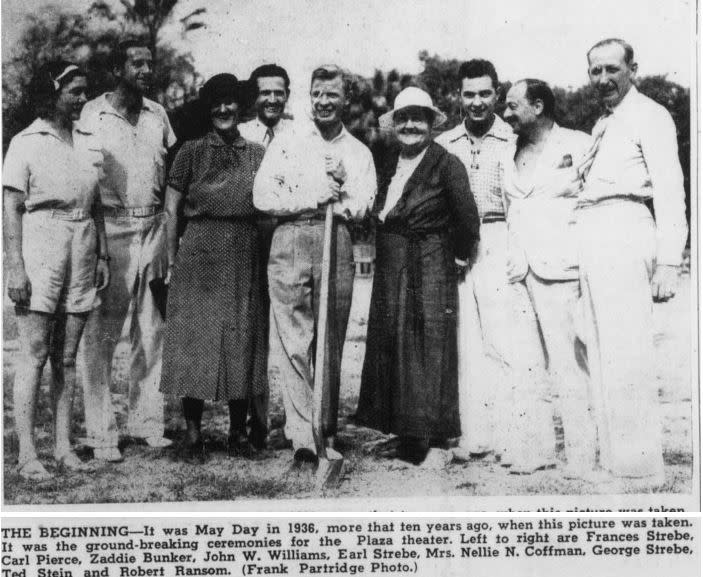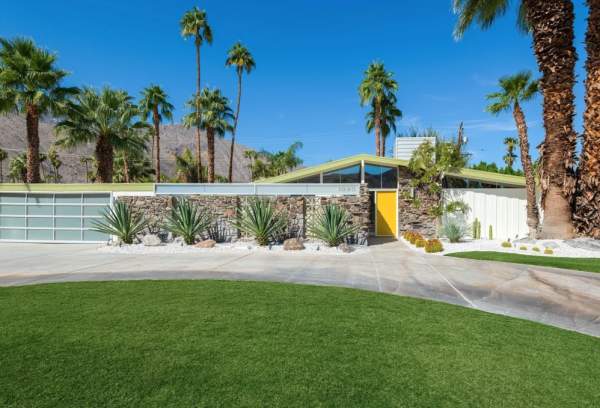Built in the striking early Spanish-style architecture, The Plaza Theatre was designed for people who loved the desert. Its high, gently curving ceiling was a dusky blue, like the sky, with tiny stars that twinkled on and off. Along either side of the simulated garden walls were little Spanish cottages, with soft illumination so that they appeared to be occupied.
Julia Carnell: The Visionary Behind the Theatre
The Plaza Theatre was built thanks to the vision and generosity of Julia Carnell, a Dayton, Ohio, philanthropist and heiress to the National Cash Register (NCR) fortune. Widowed in 1932, Carnell became a noted patron of architecture and the arts. She was instrumental in developing what is now the Dayton Art Institute and used her resources to fund civic projects that enriched public life.

Drawn to Palm Springs for its natural beauty and elite seasonal society, Carnell wintered at the famed Desert Inn, where she befriended owner Nellie Coffman and envisioned Palm Springs as more than a desert retreat- it could be a cultural destination. She funded the development of the La Plaza complex—one of the country's first mixed-use commercial centers that integrated shops, offices, and entertainment. As part of that vision, she built the Plaza Theatre to bring first-run Hollywood films and world-class entertainment to Palm Springs residents and visitors.
Carnell's elegant sensibilities influenced the design of the entire La Plaza complex. The theater, in particular, blended function with style, offering modern amenities and refined details that were rare in desert towns at the time. Her legacy lives on as one of the founding figures in Palm Springs' architectural and cultural identity.
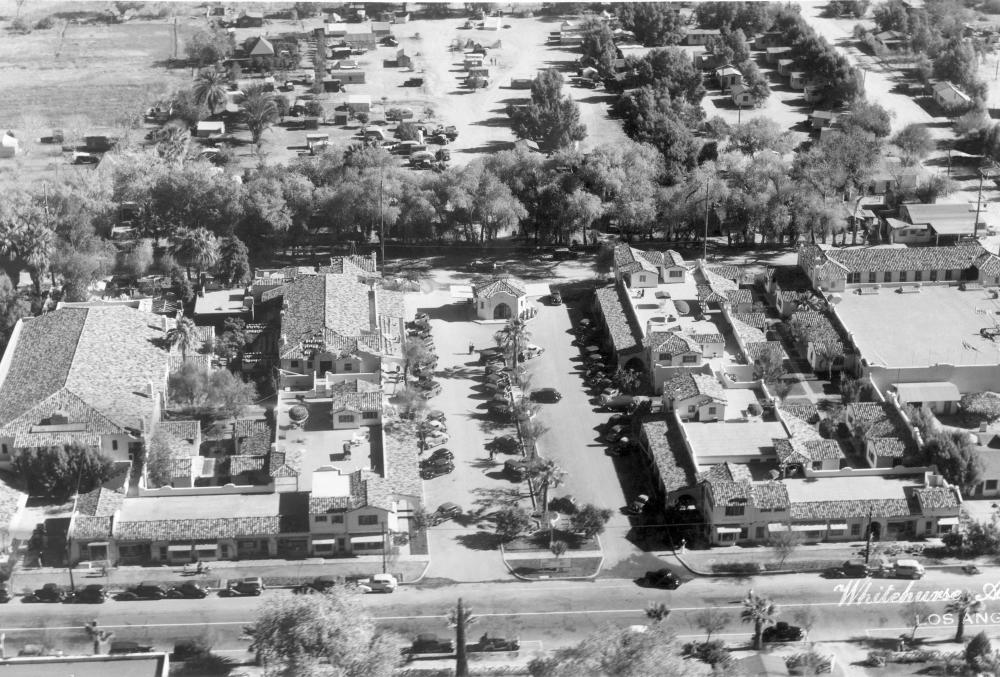
Earle Strebe Becomes First Theater Manager
Earle Strebe came to the valley around 1927 and worked as a bellman in Nellie Coffman's Desert Inn. At Earl Coffman's suggestion, Strebe began screening motion pictures for the guests at the Desert Inn on Wednesday and Friday nights. Soon, the Oasis Hotel also asked him to show films part-time. Seeing the popularity of the shows, Strebe decided to open a theater. With the help of the school board, made up of Nellie Coffman, Alvah Hicks, and Cornelia White, Strebe opened his movie house in the auditorium of Francis Stevens's School. He showed silent pictures at first and, in 1930, brought sound movies to the desert.
Earle married Frances Bunker, the daughter of Zaddie Bunker. In 1933, with the backing of Zaddie and using her land, Strebe opened his first movie house- the 499-seat Village Theater, which quickly attracted Hollywood regulars.
In mid-1936, Earle leased the theater that was being built as part of Julia's La Plaza complex.

Earl Strebe sells the first ticket at The Plaza Theatre, 1936
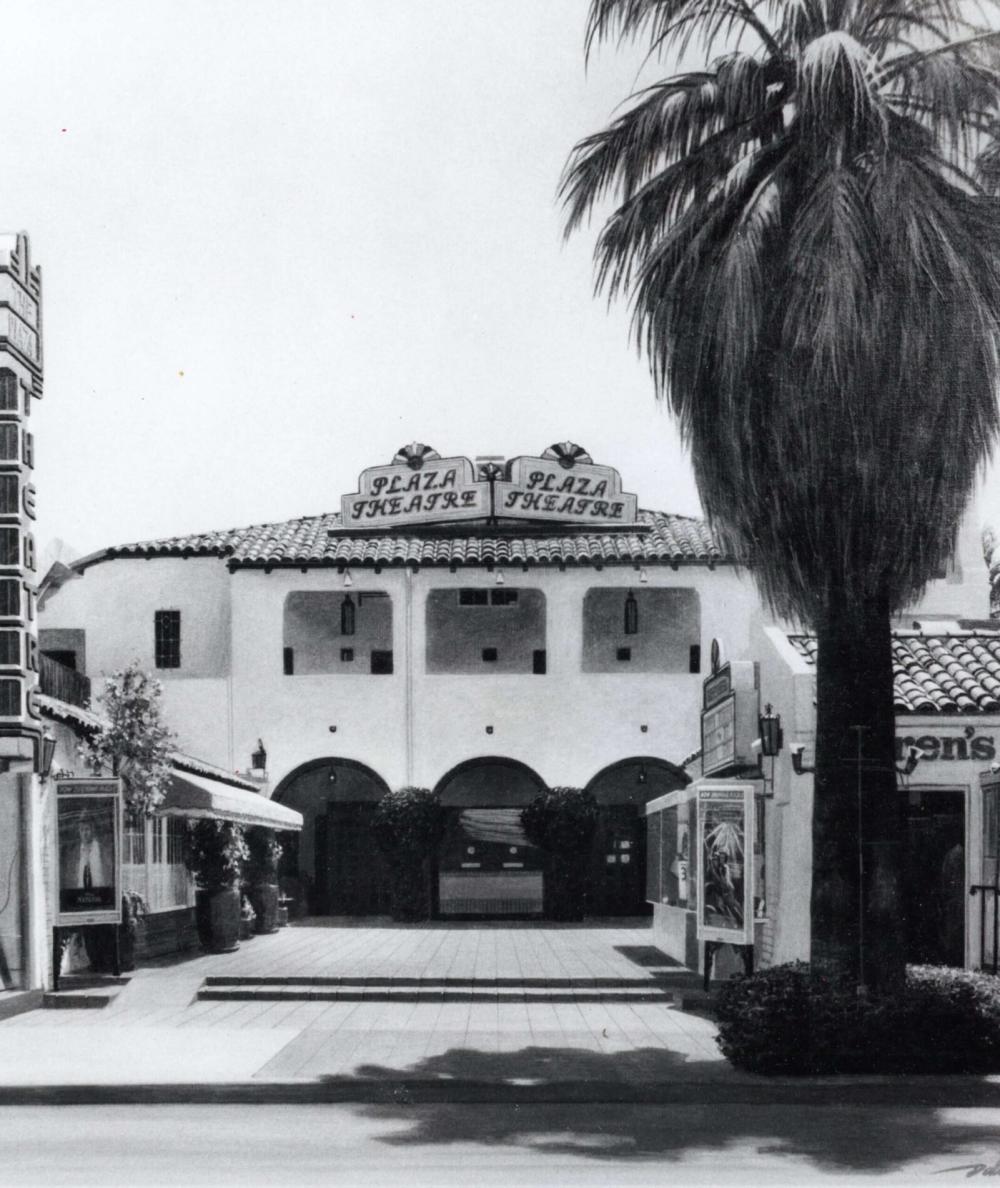
A Hollywood Opening Night
With the help of actor Ralph Bellamy—who served as master of ceremonies for the premiere—Palm Springs welcomed the glitz of Tinseltown with open arms.
On opening night, the Plaza Theatre hosted the world premiere of Camille, made possible through the cooperation of Metro-Goldwyn-Mayer and actor Ralph Bellamy, who served as master of ceremonies. The glamorous evening featured appearances by Hollywood legends, including Robert Taylor, Allan Jones, Barbara Stanwyck, Tyrone Power, Shirley Temple, and many others. Rumor has it that Greta Garbo herself slipped in to watch the film—incognito, of course.
Local matriarch Nellie Coffman, owner of the Desert Inn and an early promoter of Palm Springs as a resort destination, gave a speech that received resounding applause from the packed audience. The event solidified the Plaza Theatre's role as a magnet for the desert's growing roster of celebrity residents and vacationers.
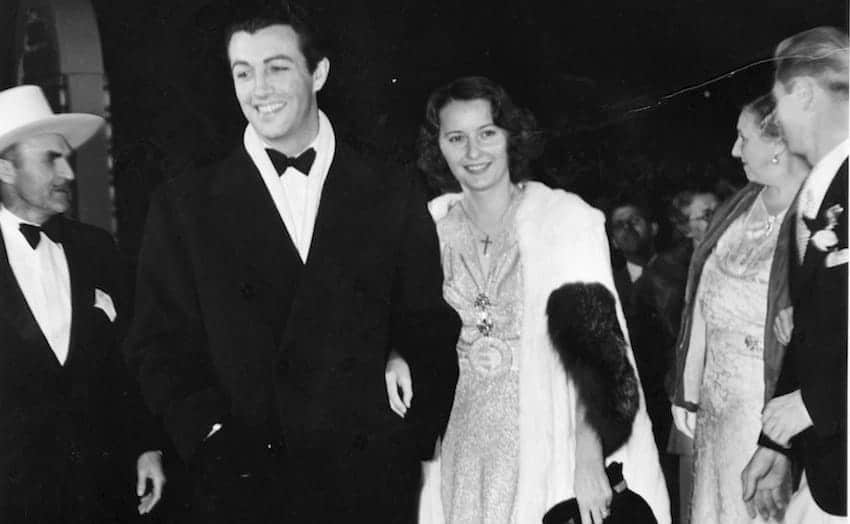
The Golden Age of Radio
Jack Benny
By 1940, the theater had become more than just a movie house—it was a broadcasting studio for one of America's most prominent radio stars, Jack Benny. It was the most significant publicity break for Palm Springs in some time. Earl Strebe had been working with the team that handles the Benny program for weeks and was largely instrumental in getting the show to Palm Springs.
Jack brought his full cast to Palm Springs for two special broadcasts from the Plaza Theatre in February of 1941. The shows included Mary Livingston (his wife), Phil Harris, Dennis Day, Don Wilson, and the iconic Rochester. Benny paid out of pocket to bring his production to the desert, illustrating both his love for Palm Springs and the theater's growing cultural cachet. Tickets sold out quickly, and the performances became legendary among locals. There were over 3,000 people requesting tickets, with less than 1,600 seats available.
Note: Jack Benny purchased his first home at 987 N. Avenida Palos Verdes in 1951. He later bought a house at 424 W Vista Chino in 1965, where he lived until his death in 1974.
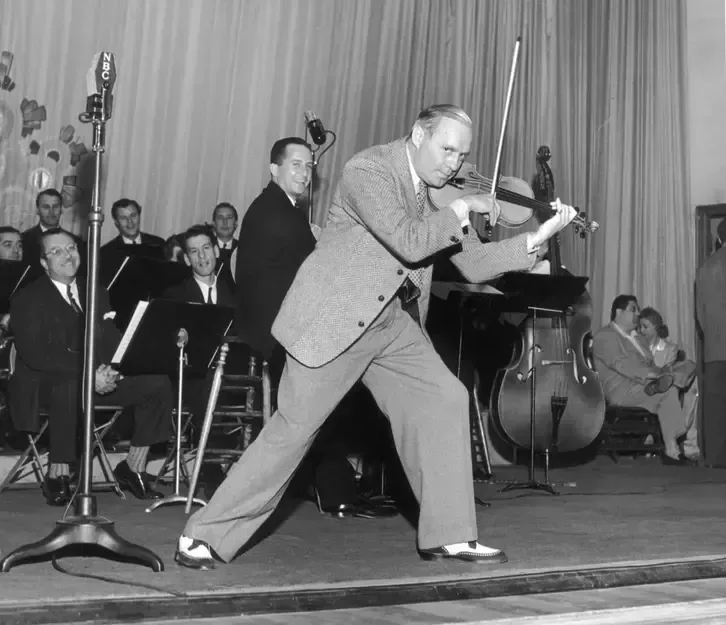
Frank Sinatra
On February 20, 1946, the Plaza Theatre in Palm Springs hosted a landmark event: a 90-minute live radio broadcast featuring Frank Sinatra, marking the inaugural program for the City's first radio station, KCMJ (1340 AM). This gala performance was organized as a benefit for the Palm Springs War Memorial Fund and was attended by notable figures, including Jack Benny, who made a special appearance.
Fun Fact: Frank Sinatra had his home built by Stewart Williams in 1947 at 1148 East Alejo Road. It is now called the Twin Palms Estate and is available for rent.
Big Tops and Bright Lights: Circus Week and the Village Vanities at the Plaza Theatre
Circus Week was a vibrant annual celebration in Palm Springs. Initially, it featured a variety of community events, including parades and performances, designed to bring together residents and visitors alike. One of the highlights of Circus Week was a theatrical revue known as the Village Insanities, which showcased local talent through music, comedy, and dance performances.
Originally held at the Desert Inn, the Village Insanities variety show moved to the Plaza Theatre in the 1940s and was rebranded as the Village Vanities. The new venue allowed for more elaborate staging and drew larger audiences during Circus Week. The Plaza Theatre, with its state-of-the-art facilities for the time, provided an ideal venue for such performances. The Village Vanities continued the tradition of community involvement, often featuring local performers and drawing large crowds during Circus Week.

More World Premiers
The Plaza Theatre wasn't just a place to see movies—it was where Hollywood came to launch them. Over the decades, it played host to dazzling world premieres that brought the stars out under the desert sky. These events helped solidify Palm Springs' reputation as Hollywood's playground.
"Forever Female" – November 28, 1953
The world premiere of Forever Female, a comedy starring Ginger Rogers and William Holden, drew a massive crowd to the Plaza Theatre. Rogers arrived in classic glamour, stunning fans with her desert-appropriate elegance, while Holden charmed the crowd and posed for local photographers. The film went on to win a Golden Globe for Best Screenplay, but in Palm Springs, it was the red carpet glamour that stole the show.
Note: William Holden purchased his first Palm Springs home in 1967 at 1323 S. Driftwood Drive, where he lived until 1977. He bought a lot in the Southridge neighborhood in 1971, where he built a new home designed by Hugh Kaptur. He moved into his new home in 1977. He owned this home until his death in 1981.

"That Certain Feeling" – May 28, 1956
Comedian Bob Hope and Oscar-winner Eva Marie Saint headlined this romantic comedy, which premiered with great fanfare. Although this was more of a press premiere, the guest list read like a who's who of mid-century showbiz royalty—Lucille Ball, Groucho Marx, George Burns, Alan Ladd, and Esther Williams were all spotted among the crowd, joined by screenwriters Norman Panama and Melvin Frank, who also directed the film.
Edith Head attended and provided a rundown on the clothes she designed. She had already won six Academy Awards for costume design, the first time in 1949 for "The Heiress."
Note:
- Bob Hope purchased his first home in Palm Springs in 1941 at 1014 East Buena Vista Drive. The most well-known is the residence at 2466 Southridge Drive, which was completed in 1979.
- Edith Head owned a home at 1172 May Drive
See the 1956 silent newsreel footage.
"The House of the Seven Hawks" – December 2, 1959
Hollywood heartthrob Robert Taylor returned to the Plaza Theatre nearly 25 years after opening it with Camille to premiere this British-American mystery film. Fans lined the street to catch a glimpse of Taylor, whose lasting appeal was evident in the enthusiastic turnout. His wife, actress Ursula Thiess, joined him at the premiere, adding to the event's old Hollywood sparkle.

"A Guide for the Married Man" – April 28, 1967
Directed by Gene Kelly, this all-star comedy brought an astonishing array of stars to the Plaza for its world premiere. It was televised on 148 stations, including London, Paris, Rome, and West Germany. On hand for the occasion were Gene Kelly, the film's director, Joan Crawford, Lucille Ball, Michael Landon, Lee Majors, George Montgomery, Troy Donahue, Patty Duke, and many other personalities.
"The Illustrated Man" – March 21, 1969
Based on stories by Ray Bradbury, this science-fiction drama starred Rod Steiger and Claire Bloom, both of whom attended the premiere. The screening attracted the intellectual crowd of Hollywood, including Eva Gabor, Jolie Gabor, Robert Wagner, Jack Benny, Kirk Douglas, and Henry Fonda. Steiger, known for his intensity, gave interviews before the screening, praising the Plaza Theatre's intimate setting and the town's hospitality.
Notes:
- Robert Wagner owned a home in Palm Springs at 303 West Crestview Drive that he purchased in 1968. He honeymooned here with Natalie Wood on the second attempt at marriage in 1972.
- Kirk Douglas owned a home at 515 West Via Lola, which he purchased in 1957 and sold in 1999.
- Ray Bradbury loved Palm Springs and purchased a home at 1837 S. Caliente Road in 1981.
- Jolie Gabor was the mother of the Gabor sisters. She lived in Palm Springs and owned Pearl-Jewelry Salon at 219 S. Palm Springs.

Barbara Zappo Marx was on the planning committee. In 1976, she married Frank Sinatra.

Changing Hands and Changing Times
Julia Carnell passed away in 1944, and the Plaza Theatre passed to her heirs. After a period of financial trouble, the property was sold in 1951 to the Plaza Investment Company and then in 1955 to longtime manager Earle Strebe. Under Strebe's continued leadership, the theater pioneered the area's first wide-angle movie screen and maintained a loyal following.
In 1974, Strebe leased the property to producer Fred Stein, who had operated the Century Cinema Circuit since 1960 and was a resident. It later merged with Metropolitan Theatre Corporation in 1977, and they removed the sidewalk ticket booth.

A Fight for Preservation
Earl Strebe still owned the property when the City Council approved an agreement on December 7, 1988, with developer John Wessman, which would force the City to acquire the property along with one other by eminent domain or pay Wessman $800,000 in fees he claimed to have invested, thereby letting a proposed block-long project (Plaza de las Flores) die. Community members rallied to preserve the theater's historic charm, pushing back against redevelopment plans. Earl wanted to enter a long-term lease, not sell the property. He had already gifted half of his interest in the property to three daughters.
Sonny Bono became mayor in 1988 and served until 1992.
In December 1989, the Palm Springs City Council intervened. They unanimously approved a plan to lease—and later purchase—the theater and two neighboring properties. The City Redevelopment Agency entered a 9.5-year lease for $1.4 million and eventually bought the Plaza Theatre outright for $2.2 million. The adjacent properties, Louise's Pantry and Karen's Korner, were later sold to Wessman for $400,000.

Image from the Desert Sun, December 15, 1988.
The Fabulous Palm Springs Follies
Mayor Sonny Bono saw the potential for revitalization and proposed turning the historic movie house into a live playhouse. In 1991, the Plaza Theatre was designated a Class I historic site, solidifying its significance to the community. The City leased the space to Riff Markowitz and Mary Jardin, who launched The Fabulous Palm Springs Follies. This celebrated variety show highlighted entertainers "of a certain age" and ran from 1992 to 2014. The Follies breathed new life into the venue, drawing thousands of visitors and reestablishing the Plaza Theatre as a cultural mainstay.

The Plaza Theatre's Grand Revival
The historic Plaza Theatre is undergoing a meticulous restoration, aiming to blend its rich heritage with modern amenities. Scheduled for completion in December 2025, the project encompasses several key enhancements:
- Seating and Stage Enhancements: Installation of 700 new seats and an expanded stage to accommodate a variety of performances.
- Technical Upgrades: Implementation of state-of-the-art lighting and sound systems to support diverse programming, including live music, theater, and lectures.
- Accessibility Improvements: Modifications to meet current ADA standards, including wheelchair-accessible seating, ticket windows, and dressing rooms.
- Facility Modernization: Renovation of dressing rooms, restrooms, and the addition of modern air conditioning for enhanced comfort.
- Lobby and Concessions: Enclosure and air-conditioning of the outer lobby, along with the addition of a new bar and concessions area.
- Historical Preservation: Restoration of original stenciling and the unearthing of the theater's original proscenium to preserve its historic character.
- Cultural Expansion: Plans to incorporate a museum within the theater, showcasing authentic movie props and memorabilia to celebrate its cinematic legacy.
These efforts are spearheaded by the Palm Springs Plaza Theatre Foundation in collaboration with the City of Palm Springs and managed by Oak View Group. The restoration not only aims to revive the theater's former glory but also to establish it as a premier venue for arts and culture in the region.
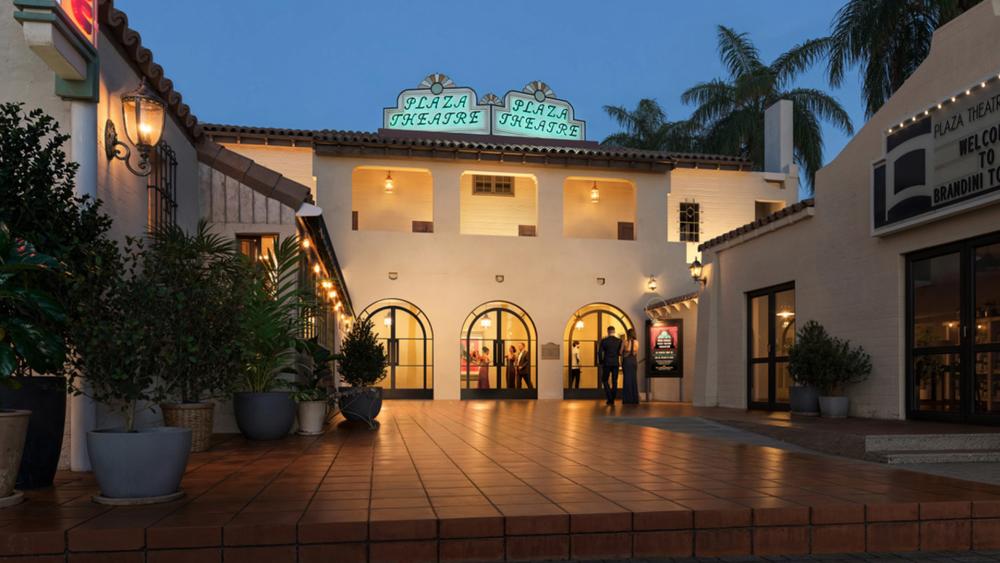 The Plaza Theatre
The Plaza Theatre
128 S. Palm Canyon Drive
Additional History Topics:
La Plaza: The Heart of Historic Palm Springs
Twin Palms: Frank Sinatra's Legendary Palm Springs Hideaway
The Untold Stories Behind Palm Springs Street Names
Explore Historic Hotels in Palm Springs
Unforgettable Palm Springs Tours: Explore Architecture, History, Nature, and Celebrity Hotspots
- 10 min read
Taking Palm Springs tours is a great way to explore and experience all…
Hike Indian Canyons: A Complete Trail Guide to Sacred Oasis
- 13 min read
Indian Canyons is a beautiful nature reserve in South Palm Springs. The…
Palm Springs Modernism Week - October
- 6 min read
Four Days of Must-See Tours and Events October 16 - 19, 2025 Tickets on…
Get ready for Halloween Palm Springs
- 9 min read
2025 October 24 - November 1, Evil Dead The Musical Location…
Palm Springs Air Museum: The World’s Largest Collection of Flyable WWI Aircraft
- 4 min read
The Palm Springs Air Museum is more than just a…
